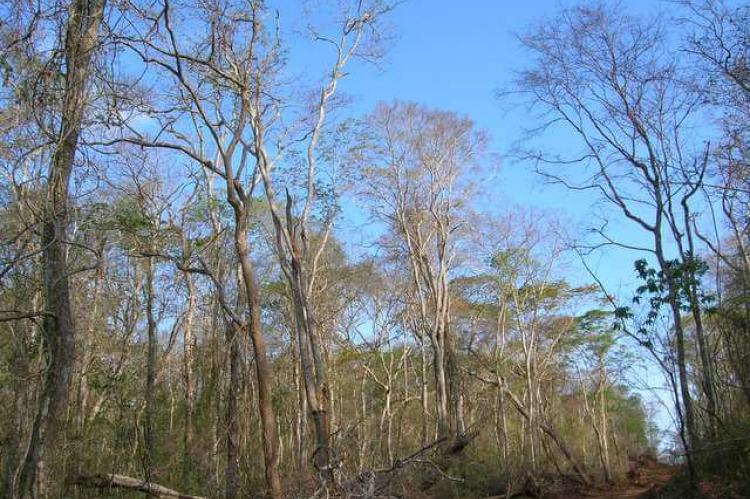The Chiquitano Dry Forests: A Biodiverse Haven
Nestled in the heart of eastern Bolivia and western Brazil, the Chiquitano dry forests ecoregion is a unique and biodiverse haven characterized by its distinct vegetation and remarkable adaptation to a semi-arid climate. This ecoregion is a tapestry of dry forests, savannas, and gallery forests.
The Chiquitano Dry Forests: A Biodiverse Haven
Nestled in the heart of eastern Bolivia, the Chiquitano dry forests ecoregion stands as a unique and biodiverse haven, characterized by its distinct vegetation and remarkable adaptation to a semi-arid climate. This ecoregion, spanning across the departments of Santa Cruz, Chuquisaca, and Tarija, is a tapestry of dry forests, savannas, and gallery forests, providing a glimpse into the resilience of nature and the intricate interplay between flora and fauna.
A Transboundary Ecoregion
While the core of the Chiquitano dry forests ecoregion is located in eastern Bolivia, it also extends across the border into western Brazil, specifically the state of Mato Grosso. This transboundary nature of the ecoregion highlights its importance as an ecological corridor and transitional zone between the Amazon Basin to the north and the Chaco region to the south.
A Semi-Arid Landscape
Climate and Topography
The Chiquitano dry forests ecoregion experiences a semi-arid climate, with a pronounced dry season lasting from May to October. Despite the arid conditions, the region is punctuated by a network of seasonal streams and rivers, which play a crucial role in sustaining the diverse ecosystems within the ecoregion.
The topography of the Chiquitano dry forests is characterized by gently rolling hills and plateaus, with elevations ranging from 300 to 1,000 meters (1,000 to 3,300 feet) above sea level. This varied terrain contributes to forming distinct microclimates and habitats, further enhancing the region's biodiversity.
Vegetation and Ecosystems
Dry Forests and Savannas
The Chiquitano dry forests ecoregion is dominated by dry deciduous and semi-deciduous forests, which have adapted to the semi-arid conditions through various strategies, such as shedding their leaves during the dry season to conserve water. These forests are interspersed with open savannas, creating a mosaic of habitats that support a diverse array of plant and animal species in Bolivia and the adjacent areas of Brazil.
Gallery Forests and Riparian Ecosystems
Gallery forests and riparian ecosystems thrive along the seasonal streams and rivers that dissect the ecoregion, starkly contrasting the surrounding dry landscapes. These lush vegetation corridors serve as important refuges for many species, offering food, water, and shelter in an otherwise arid environment.
Biodiversity Riches
Flora and Fauna Diversity
The Chiquitano dry forests ecoregion boasts a remarkable diversity of flora and fauna, with many species adapted to the region's unique conditions. The dry forests are home to various tree species, including the iconic quebracho (Schinopsis spp.) and palo blanco (Calycophyllum multiflorum), while grasses and scattered shrubs dominate the savannas.
The ecoregion supports a wide range of fauna, including the iconic giant anteater (Myrmecophaga tridactyla), the elusive jaguar (Panthera onca), and a plethora of bird species, such as the striking turquoise-fronted amazon (Amazona aestiva).
Endemic and Threatened Species
The Chiquitano dry forests ecoregion is home to several endemic species, including the Bolivian dry forest toad (Incilius machiguengai) and the Bolivian dry forest bat (Neoplatymops mattogrossensis). Additionally, the ecoregion is a vital habitat for several threatened species, such as the endangered blue-throated macaw (Ara glaucogularis) and the vulnerable giant armadillo (Priodontes maximus).
Conservation Efforts and Sustainable Development
Protected Areas and National Parks
Recognizing the ecological importance and vulnerability of the Chiquitano dry forests ecoregion, several protected areas and national parks have been established to safeguard its unique ecosystems. These include the Noel Kempff Mercado National Park, the Otuquis National Park, and the Serranía de Huanchaca National Park.
While the Bolivian portion of the Chiquitano dry forests ecoregion benefits from several protected areas and national parks, the Brazilian side has faced more intense deforestation and land conversion for agriculture and cattle ranching. Conservation efforts in Brazil have focused on creating sustainable development reserves and environmental protection areas, such as the Rio Novo National Park and the Serra da Bodoquena National Park. Maintaining ecological connectivity between the Bolivian and Brazilian portions of the ecoregion is crucial for preserving biodiversity and allowing species migration and gene flow across this transboundary ecosystem.
Sustainable Land Management
In addition to protected areas, efforts have been made to promote sustainable land management practices within the Chiquitano dry forests ecoregion. These initiatives aim to balance economic activities, such as cattle ranching and selective timber harvesting, with conserving natural resources and preserving biodiversity.
Ecotourism and Environmental Education
Ecotourism has emerged as a viable option for promoting the conservation of the Chiquitano dry forests ecoregion while providing economic opportunities for local communities. By fostering environmental education and raising awareness about the region's natural wonders, ecotourism can play a pivotal role in ensuring the long-term protection of this unique ecosystem.
Conclusion
The Chiquitano dry forests ecoregion of eastern Bolivia is a true ecological gem, offering a glimpse into nature's resilience and the incredible diversity of life that can thrive in semi-arid environments. Through a combination of protected areas, sustainable land management practices, and responsible ecotourism development, this ecoregion can continue to serve as a haven for its remarkable flora and fauna while providing valuable ecosystem services and opportunities for scientific research and environmental education.
